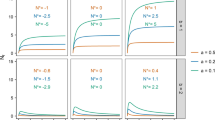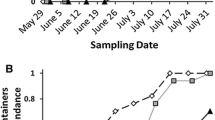Abstract
Colonization, including oviposition, is an important driver of population and community dynamics both within and across habitat patches. Most research has focused on the roles of habitat availability or quality on colonization and its outcomes. However, the spatial distribution of habitats also likely affects these processes. We conducted field experiments in Georgia, USA, using clustered and dispersed arrays of equal numbers of oviposition patches to investigate how patch aggregation influenced oviposition by Aedes mosquitoes. We tested the effects of aggregation on: (1) the total number of eggs an array received, (2) the proportion of patches within an array that received eggs, and (3) the number of eggs per colonized patch. We compared results to predictions from three models (Field of Dreams, Propagule Redirection, and Excess Attraction), which vary in the degree to which arrays attract colonists and apportion those colonists among patches. Clustered arrays received 22% more eggs than dispersed arrays, with clustered patches significantly more likely to receive eggs. At the species level, A. albopictus responded more to clustering than did A. triseriatus. These results are inconsistent with Propagule Redirection, but support the Excess Attraction and Field of Dreams models. Although clustered arrays occupied a relatively small area, they attracted at least as many ovipositing mosquitoes as did dispersed arrays. However, the number of eggs per colonized patch did not differ between clustered and dispersed arrays. Therefore, density dependence among larvae, and hence the production of adult mosquitoes on a per-patch basis, should be similar in dispersed and clustered landscapes.


Similar content being viewed by others
References
Allan SA, Kline DL (1998) Larval rearing water and preexisting eggs influence oviposition by Aedes aegypti and Ae. albopictus (Diptera: Culicidae). J Med Entomol 35(6):943–947
Alto BW, Lounibos LP, Higgs S, Juliano SA (2005) Larval competition differentially affects arbovirus infection in Aedes mosquitoes. Ecology 86:3279–3288
Alto BW, Lounibos LP, Mores CN, Reiskind MH (2008) Larval competition alters susceptibility of adult Aedes mosquitoes to dengue infection. P R Soc B-Biol Sci 275:463–471. https://doi.org/10.1146/annurev.es.25.110194.002303
Armbruster P, Hutchinson RA (2002) Pupal mass and wing length as indicators of fecundity in Aedes albopictus and Aedes geniculatus (Diptera: Culicidae). J Med Entomol 39(4):699–704
Bates D, Maechler M, Bolker BM, Walker S (2015) Fitting linear mixed-effects models using lme4. J Stat Softw 67:1–48. https://doi.org/10.18637/jss.v067.i01
Baum KA, Haynes KJ, Dillemuth FP, Cronin JT (2004) The matrix enhances the effectiveness of corridors and stepping stones. Ecology 85:2671–2676
Bender DJ, Fahrig L (2005) Matrix structure obscures the relationship between interpatch movement and patch size and isolation. Ecology 86:1023–1033
Bidlingmayer WL, Hem DG (1980) The range of visual attraction and the effect of competitive visual attractants upon mosquito (Diptera: Culicidae) flight. Bull Entomol Res 70:321–342
Binckley CA, Resetarits WJ (2005) Habitat selection determines abundance, richness and species composition of beetles in aquatic communities. Biol Let 1:370–374. https://doi.org/10.1098/rsbl.2005.0310
Bolker BM, Development Core Team R (2017) bbmle: tools for general maximum likelihood estimation. R package version 1:19
Bolker BM, Brooks ME, Clark CJ et al (2009) Generalized linear mixed models: a practical guide for ecology and evolution. Trends Ecol Evol 24:127–135. https://doi.org/10.1016/j.tree.2008.10.008
Briegel H (1990) Metabolic relationship between female body size, reserves, and fecundity of Aedes aegypti. J Insect Physiol 36(3):165–172
Crawley MJ (2002) Statistical computing: an introduction to data analysis using S-plus. Wiley, New York
Davis TJ, Kaufman PE, Hogsette JA, Kline DL (2015) The effects of larval habitat quality on Aedes albopictus skip oviposition. J Am Mosq Control Assoc 31:321–328. https://doi.org/10.2987/moco-31-04-321-328.1
Day J (2016) Mosquito oviposition behavior and vector control. Insects 7:65. https://doi.org/10.1093/ee/10.2.180
de Abreu FVS, Morais MM, Ribeiro SP, Eiras ÁE (2015) Influence of breeding site availability on the oviposition behaviour of Aedes aegypti. Mem Inst Oswaldo Cruz 110:669–676. https://doi.org/10.1590/0074-02760140490
Delatte H, Gimonneau G, Triboire A, Fontenille D (2009) Influence of temperature on immature development, survival, longevity, fecundity, and gonotrophic cycles of Aedes albopictus, vector of chikungunya and dengue in the Indian Ocean. J Med Entomol 46:33–41. https://doi.org/10.1603/033.046.0105
Dieng H, Boots M, Tsuda Y, Takagi M (2003) A laboratory oviposition study in Aedes albopictus (Diptera: Culcidae) with reference to habitat size, leaf litter and their interactions. Med Entomol Zool 54:43–50
Dussault C, Ouellet J-P, Courtois R, Huot J, Breton L, Jolicoeur H (2005) Linking moose habitat selection to limiting factors. Ecography 28(5):619–628
Edgerly JS, Willey MS, Livdahl TP (1993) The community ecology of Aedes egg hatching: implications for a mosquito invasion. Ecol Entomol 18:123–128
Edgerly JS, McFarland M, Morgan P, Livdahl TP (1998) A seasonal shift in egg-laying behaviour in response to cues of future competition in a treehole mosquito. J Anim Ecol 67:805–818
Fader JE, Juliano SA (2014) Oviposition habitat selection by container-dwelling mosquitoes: responses to cues of larval and detritus abundances in the field. Ecol Entomol 39:245–252. https://doi.org/10.1111/een.12095
Fonseca DM, Kaplan LR, Heiry RA, Strickman D (2015) Density-dependent oviposition by female (Diptera: Culicidae) spreads eggs among containers during the summer but accumulates them in the fall. J Med Entomol 52(4):705–712
Fox J, Weisberg S (2011) An R companion to applied regression. Sage Publications, Thousand Oaks
Gilles JRL, Lees RS, Soliban SM, Benedict MQ (2011) Density-dependent effects in experimental larval populations of Anopheles arabiensis (Diptera: Culicidae) can be negative, neutral, or overcompensatory depending on density and diet levels. J Med Entomol 48:296–304. https://doi.org/10.1603/ME09209
Grindeland JM, Sletvold N, Ims RA (2005) Effects of floral display size and plant density on pollinator visitation rate in a natural population of Digitalis purpurea. Funct Ecol 19:383–390. https://doi.org/10.1007/s004420050495
Hamman EA, McKinley SA, Stier AC, Osenberg CW (2018) Landscape configuration drives persistent spatial patterns of occupant distributions. Theor Ecol 11:111–127. https://doi.org/10.1007/s12080-017-0352-1
Hanski I (1998) Metapopulation dynamics. Nature 396:41–49
Honorio NA, Silva WD, Leite PJ et al (2003) Dispersal of Aedes aegypti and Aedes albopictus (Diptera : Culicidae) in an urban endemic dengue area in the State of Rio de Janeiro, Brazil. Mem Inst Oswaldo Cruz 98:191–198
Keen WH (1982) Habitat selection and interspecific competition in two species of plethodontid salamanders. Ecology 63:94–102. https://doi.org/10.2307/1937035
Keller DA, Gittman RK, Bouchillon RK, Fodrie FJ (2017) Life stage and species identity affect whether habitat subsidies enhance or simply redistribute consumer biomass. J Anim Ecol 86:1394–1403. https://doi.org/10.1098/rspb.2012.0313
Klinkhamer PG, de Jong TJ (1990) Effects of plant size, plant density and sex differential nectar reward on pollinator visitation in the protandrous Echium vulgare (Boraginaceae). Oikos 57:399–405
Livdahl TP, Willey MS (1991) Prospects for an invasion: competition between Aedes albopictus and native Aedes triseriatus. Science 253:189–191
Loreau M, Mouquet N (1999) Immigration and the maintenance of local species diversity. Am Nat 154:427–440. https://doi.org/10.1086/303252
Lowenberger CA, Rau ME (1994) Selective Oviposition by Aedes aegypti (Diptera: Culicidae) in response to a larval parasite, Plagiorchis elegans Trematoda: Plagiorchiidae). Environ Entomol 23:1269–1276
Marini F, Caputo B, Pombi M, Tarsitani G, Della Torre A (2010) Study of dispersal in Rome, Italy, using sticky traps in mark-release-recapture experiments. Med Vet Entomol 24(4):361–368
Medeiros MCI, Boothe EC, Roark EB, Hamer GL (2017) Dispersal of male and female Culex quinquefasciatus and Aedes albopictus mosquitoes using stable isotope enrichment. PLoS Negl Trop Dis 11:e0005347. https://doi.org/10.1371/journal.pntd.0005347.s001
Mouquet N, Loreau M (2003) Community patterns in source-sink metacommunities. Am Nat 162:544–557. https://doi.org/10.1086/378857
Niebylski ML, Craig GB (1994) Dispersal and survival of aedes albopictus at a scrap tire yard in Missouri. J Am Mosq Control Assoc 10:339–343
Oliva LO, Correia JC, Albuquerque CMR (2013) How mosquito age and the type and color of oviposition sites modify skip-oviposition behavior in Aedes aegypti (Diptera: Culicidae)? J Insect Behav 27:81–91. https://doi.org/10.1093/jmedent/35.5.782
Osenberg CW, St Mary CM, Wilson JA, Lindberg WJ (2002) A quantitative framework to evaluate the attraction–production controversy. ICES J Mar Sci 59:S214–S221. https://doi.org/10.1006/jmsc.2002.1222
Palmer MA, Ambrose RF, Poff N (1997) Ecological theory and community restoration ecology. Restor Ecol 5:291–300
Pamplona LD, Alencar CH, Lima JWO, Heukelbach J (2009) Reduced oviposition of Aedes aegypti gravid females in domestic containers with predatory fish. Trop Med Int Health 14:1347–1350. https://doi.org/10.1093/jmedent/35.5.782
Ponnusamy L, Xu N, Nojima S et al (2008) Identification of bacteria and bacteria-associated chemical cues that mediate oviposition site preferences by Aedes aegypti. Proc Natl Acad Sci 105:9262–9267
R Core Team (2016) R: a language and environment for statistical computing. https://www.R-project.org/. Accessed 19 May 2018
Reinert JF (2000) New classification for the composite genus Aedes (Diptera: Culicidae: Aedini), elevation of subgenus Ochlerotatus to generic rank, reclassification of the other subgenera, and notes on certain subgenera and species. J Am Mosq Control Assoc 16:175–188
Reiskind MH, Greene KL, Lounibos LP (2009) Leaf species identity and combination affect performance and oviposition choice of two container mosquito species. Ecol Entomol 34:447–456. https://doi.org/10.1093/jmedent/35.6.967
Resetarits WJ, Binckley CA (2009) Spatial contagion of predation risk affects colonization dynamics in experimental aquatic landscapes. Ecology 90(4):869–876
Resetarits WJ, Binckley CA (2014) Species responses of colonising beetles to variation in patch quality, number, and context in experimental aquatic landscapes. Ecol Entomol 39(2):226–235
Resetarits WJ Jr, Silberbush A (2016) Local contagion and regional compression: habitat selection drives spatially explicit, multiscale dynamics of colonisation in experimental metacommunities. Ecol Lett 19:191–200. https://doi.org/10.1111/ele.12553
Rieger JF, Binckley CA, Resetarits WJ (2004) Larval performance and oviposition site preference along a predation gradient. Ecology 85(8):2094–2099
Stier AC, Osenberg CW (2010) Propagule redirection: habitat availability reduces colonization and increases recruitment in reef fishes. Ecology 91:2826–2832
Trexler JD, Apperson CS, Schal C (1998) Laboratory and field evaluations of oviposition responses of Aedes albopictus and Aedes triseriatus (Diptera: Culicidae) to oak leaf infusions. J Med Entomol 35:967–976
Vonesh JR, Kraus JM, Rosenberg JS, Chase JM (2009) Predator effects on aquatic community assembly: disentangling the roles of habitat selection and post-colonization processes. Oikos 118:1219–1229. https://doi.org/10.1007/s004420100784
Walsh RK, Facchinelli L, Ramsey JM et al (2011) Assessing the impact of density dependence in field populations of Aedes aegypti. J Vector Ecol 36:300–307
Yoshioka M, Couret J, Kim F et al (2012) Diet and density dependent competition affect larval performance and oviposition site selection in the mosquito species Aedes albopictus (Diptera: Culicidae). Parasites Vectors 5:45. https://doi.org/10.1186/1756-3305-5-225
Zahiri N, Rau ME, Lewis DJ (1997) Oviposition responses of aedes aegypti and Ae. atropalpus (Diptera: Culicidae) females to waters from conspecific and heterospecific normal larvae and from larvae infected with plagiorchis elegans (Trematoda: Plagiorchiidae). J Med Entomol 34(5):565–568
Acknowledgements
We thank C. Sweeney for her help in the lab and field, as well as R. Skinner, K. Clancy, A. Strickland, and A. Pylant for their help with lab work. We also thank C. Murdock, M. Evans, and P. McCannon for use of research supplies, help with field and lab protocols, and training in mosquito species identification. In addition, we would also like to thank J. Drake for the use of his mosquito rearing equipment and lab space, and the University of Georgia for funding this research.
Author information
Authors and Affiliations
Contributions
AAB and CWO conceived and designed the experiments. AAB performed the experiments and analyzed the data. AAB and CWO wrote the manuscript.
Corresponding author
Additional information
Communicated by David Chalcraft.
Electronic supplementary material
Below is the link to the electronic supplementary material.
Rights and permissions
About this article
Cite this article
Briggs, A.A., Osenberg, C.W. Spatial aggregation of aquatic habitats affects oviposition patterns in Aedes mosquitoes. Oecologia 190, 835–845 (2019). https://doi.org/10.1007/s00442-019-04448-3
Received:
Accepted:
Published:
Issue Date:
DOI: https://doi.org/10.1007/s00442-019-04448-3




